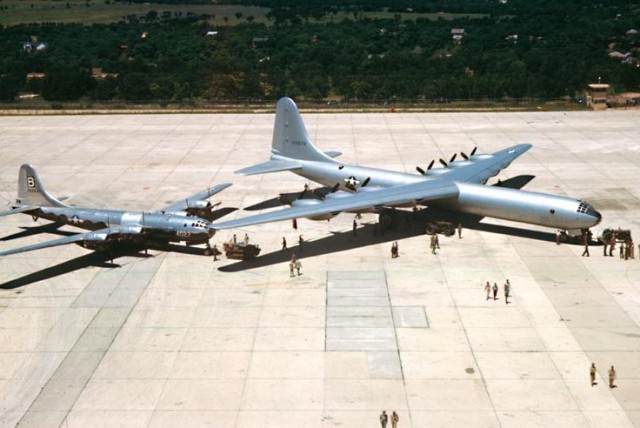
The Convair B-36 “Peacemaker” was a strategic bomber operated solely by the United States Air Force (USAF) from 1949 to 1959. The B-36 was the largest mass-produced piston engine aircraft ever made.
It had the longest wingspan of any combat aircraft ever built at 230 ft. The B-36 was the first bomber capable of delivering any of the nuclear weapons in the U.S. arsenal from inside its four bomb bays without aircraft modifications. With a range of 10,000 miles and a maximum payload of 87,200 lb, the B-36 was the world’s first manned bomber with an unrefueled intercontinental range.
The B-36 was the primary nuclear weapons delivery vehicle of the Strategic Air Command (SAC) until it was replaced by the jet-powered Boeing B-52 Stratofortress (which first became operational in 1955). The B-36 set the standard for range and payload for subsequent U.S. intercontinental bombers.
In particular, the United States Navy saw it as a costly bungle, diverting congressional funding and interest from naval aviation and aircraft carriers in general, and carrier–based nuclear bombers in particular.
With the appearance of the Soviet MiG-15 in combat over North Korea in 1950, USAF propeller-driven bombers were rendered obsolete as strategic offensive weapons.
The B-36, along with the B-29/B-50 Superfortresses in the USAF inventory in the early 1950s, were all designed during World War II before the jet age. It would take a new generation of swept-wing jet bombers, able to fly higher and faster, to effectively overcome defense by MiG-15 or subsequent Soviet-designed interceptors.
With the end of fighting in Korea, President Eisenhower, who had taken office in January 1953, called for a “new look” at national defense. The Air Force retired nearly all of its B-29/B-50s to be replaced by the new Boeing B-47 Stratojet. By 1955, the swept-wing Boeing B-52 Stratofortress was entering the inventory in substantial numbers, replacing B-36s.
The two main factors contributing to the obsolescence of the B-36 and leading to its phaseout were:
- The Peacemaker was not designed for aerial refueling and required intermediate refueling bases to reach its planned targets deep in the Soviet Union.
- Its slow speed made it vulnerable to Soviet jet interceptor aircraft, making long-range bombardment flights over Soviet territory extremely hazardous, seriously compromising its ability to reach its planned target and return.
Defense cutbacks in 1958 compelled the B-52 procurement process to be stretched out and the B-36 service life to be extended. The B-36s remaining in service were supported with components scavenged from aircraft sent to Davis-Monthan. Further update work was undertaken by Convair at San Diego until 1957 to extend the life and capabilities of the B-36s. By December 1958, only 22 B-36Js were still operational.
On 12 February 1959, the last B-36J built, Airforce Serial number 52-2827, left Biggs airforce base, Texas, where it had been on duty with the 95th Heavy Bombardment Wing. It was flown to Amon Carter Field in Fort Worth, where it was put on display.
Within two years, all B-36s, except five used for museum display, had been scrapped at Davis-Monthan Airforce base.


Δεν υπάρχουν σχόλια:
Δημοσίευση σχολίου